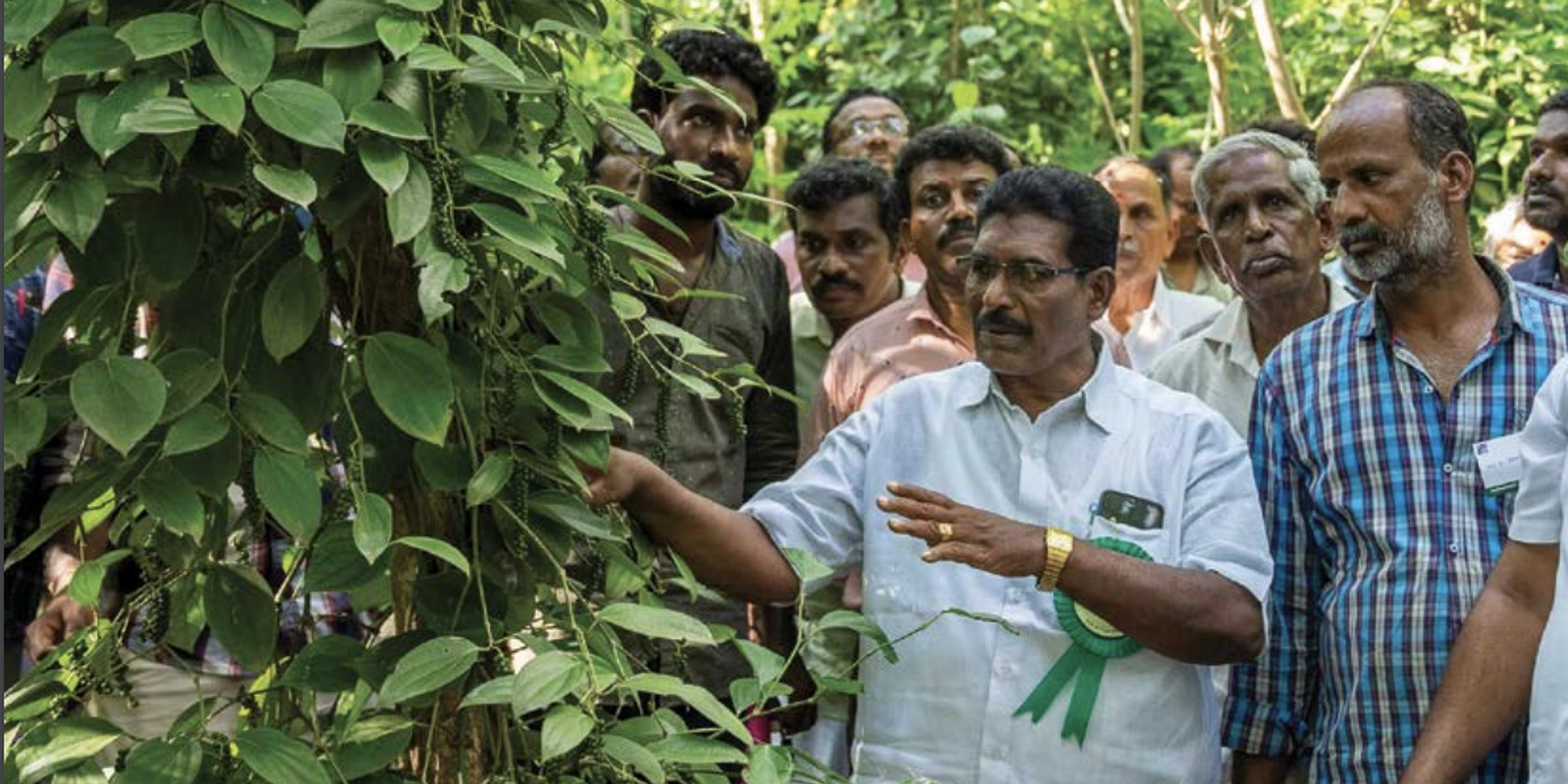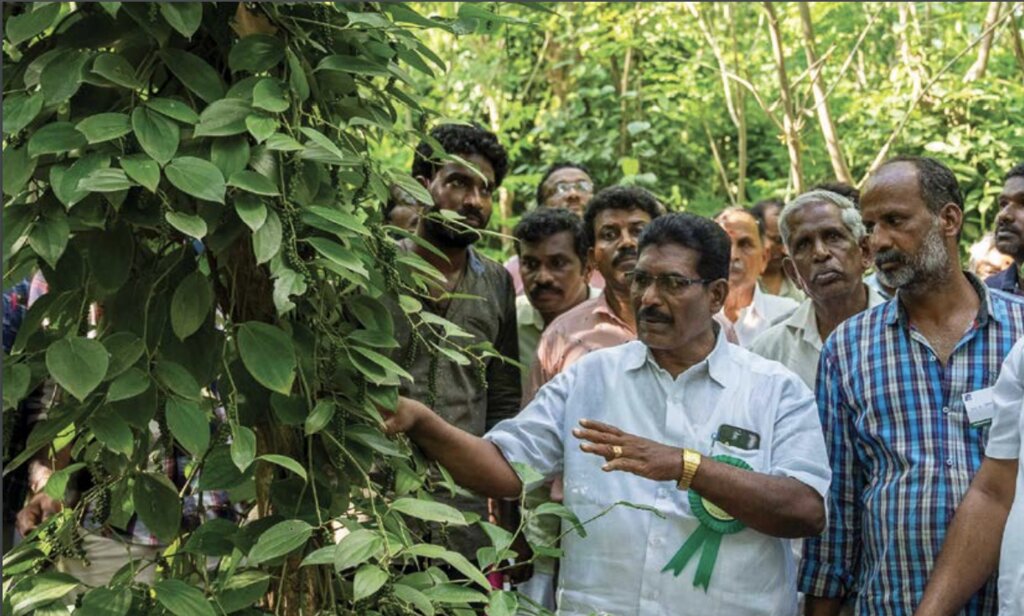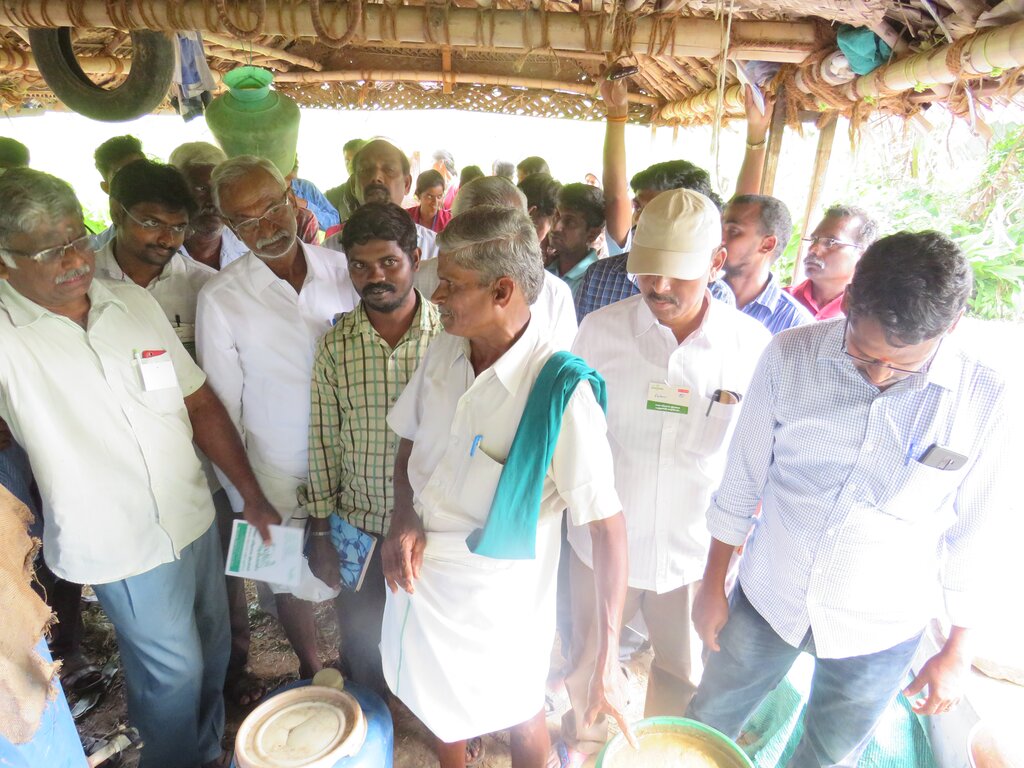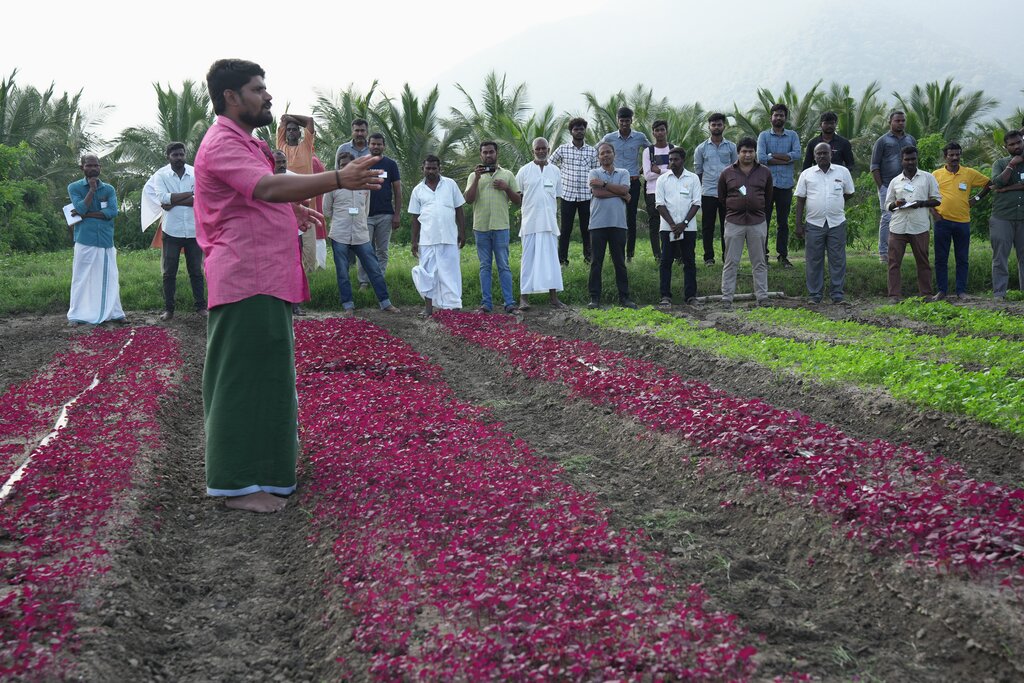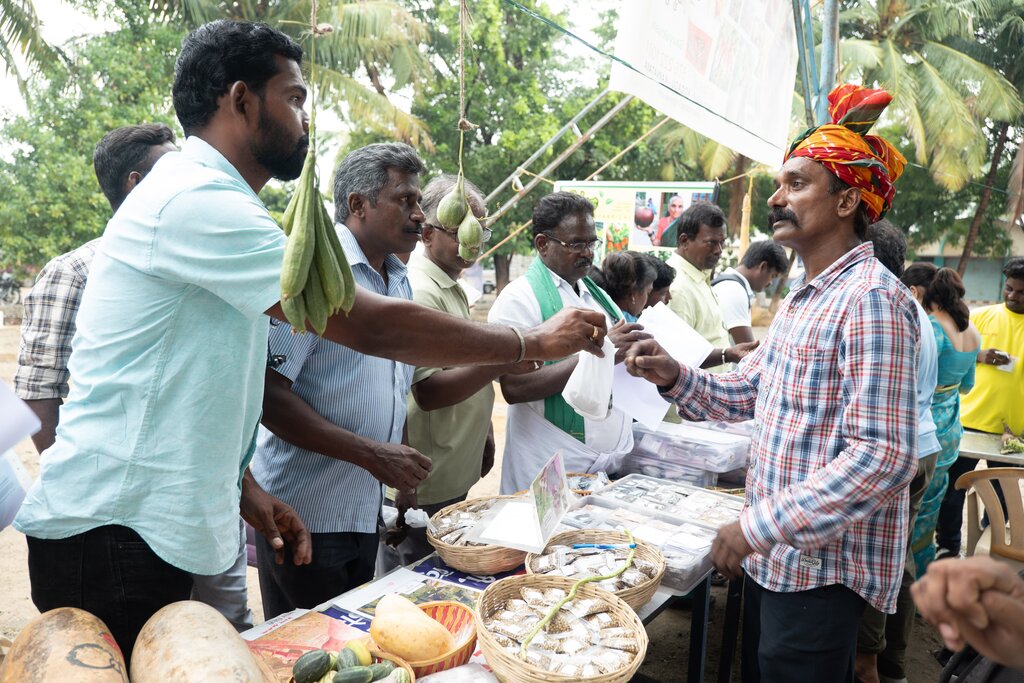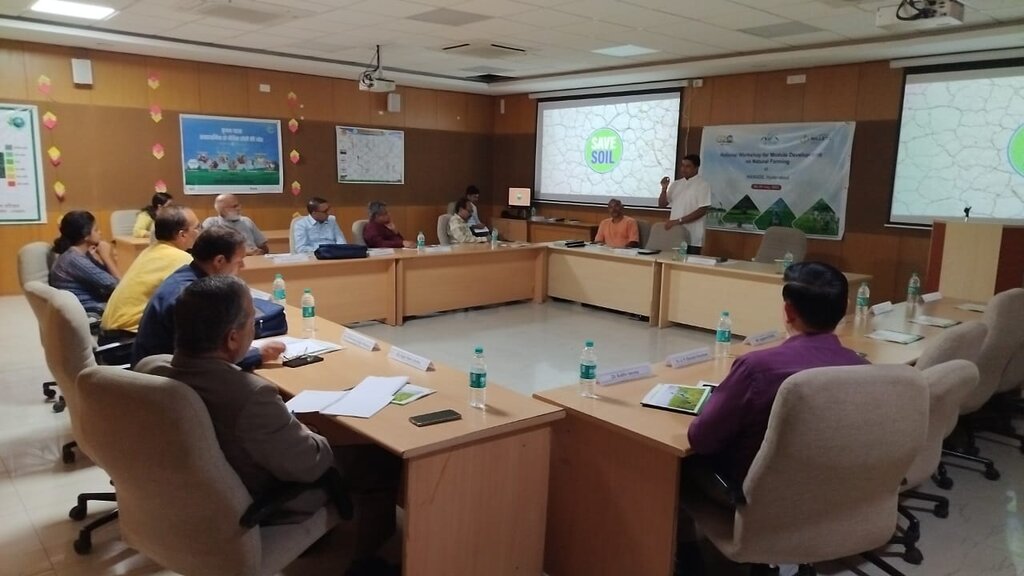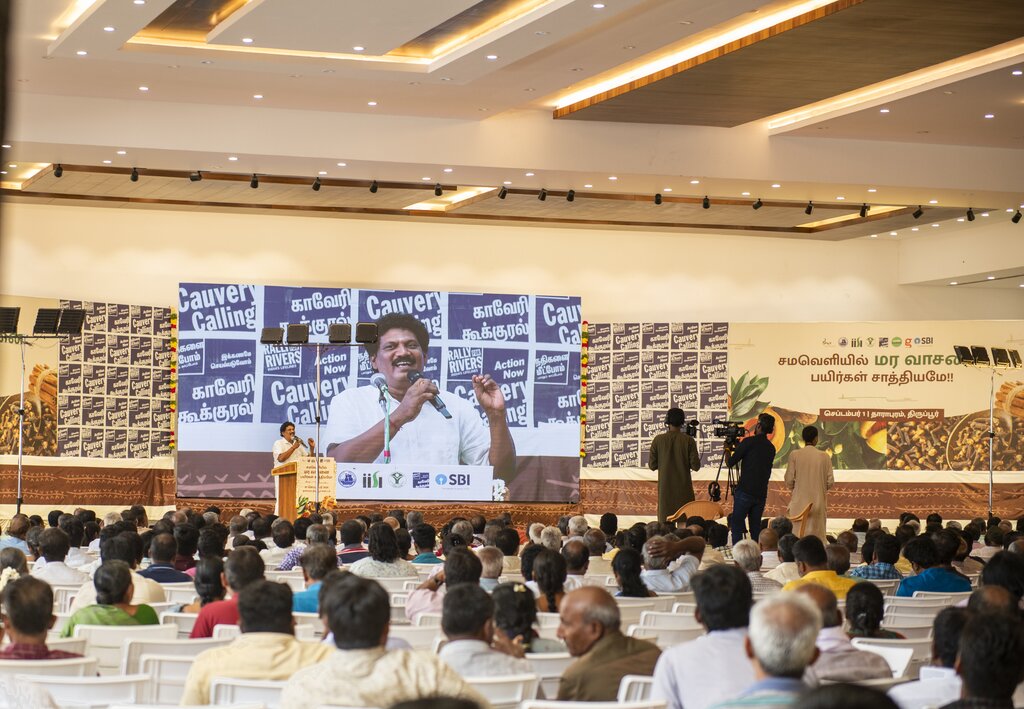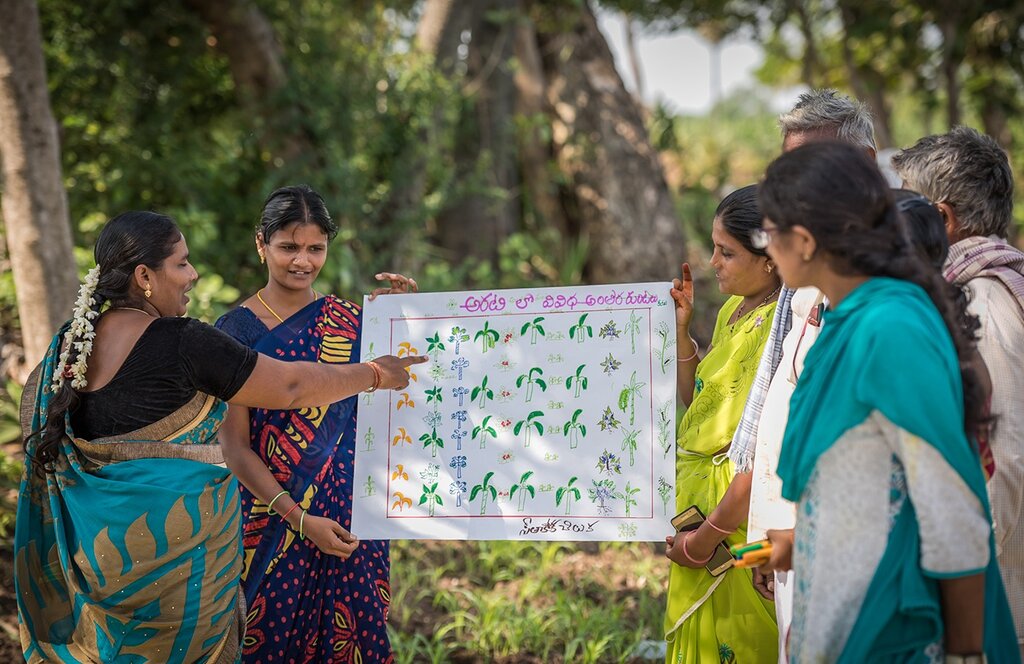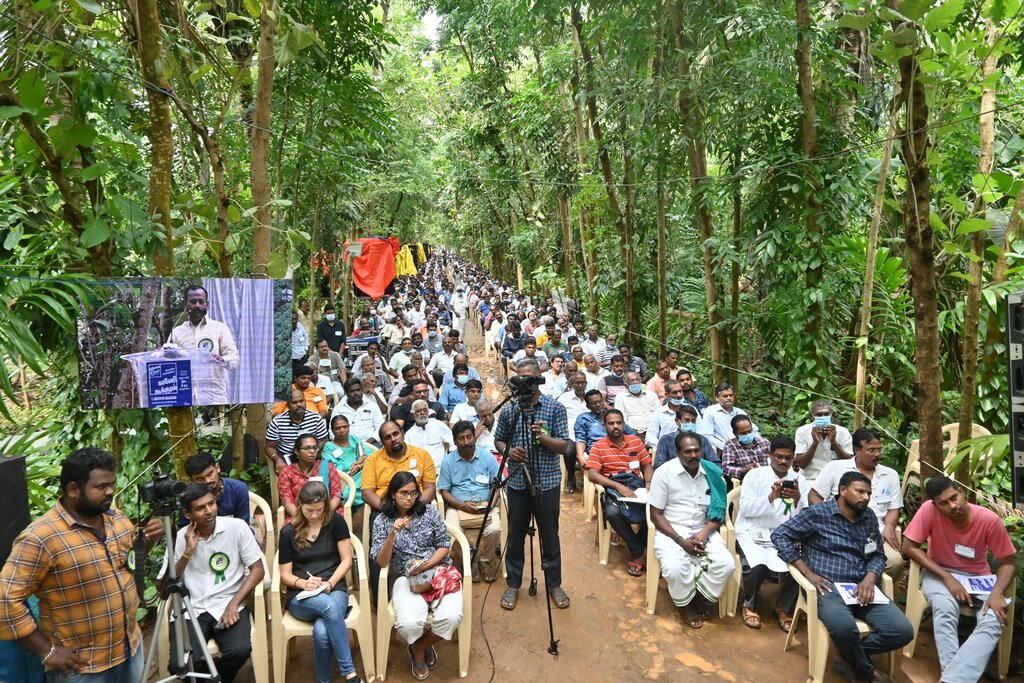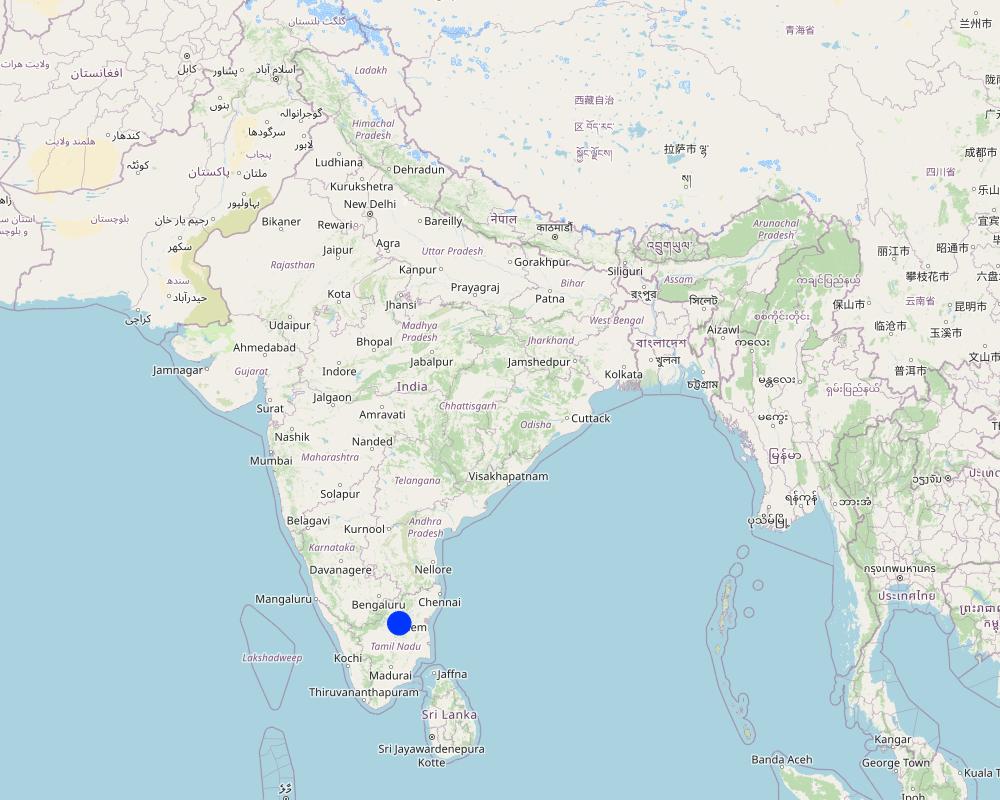Conscious Planet - Save Soil’s Farmer Training and Handholding Approach [India]
- Creation:
- Update:
- Compiler: Praveena Sridhar
- Editors: Dhyana Balasubramanian, Rushabh Desadla, Aditya Tated, Vishwesh Singh, Lu Yu
- Reviewers: William Critchley, Joana Eichenberger
approaches_7372 - India
View sections
Expand all Collapse all1. General information
1.2 Contact details of resource persons and institutions involved in the assessment and documentation of the Approach
SLM specialist:
SLM specialist:
Name of project which facilitated the documentation/ evaluation of the Approach (if relevant)
Save Soil MovementName of the institution(s) which facilitated the documentation/ evaluation of the Approach (if relevant)
Conscious Planet - Save Soil (Save Soil)1.3 Conditions regarding the use of data documented through WOCAT
When were the data compiled (in the field)?
25/10/2024
The compiler and key resource person(s) accept the conditions regarding the use of data documented through WOCAT:
Ja
1.4 Reference(s) to Questionnaire(s) on SLM Technologies
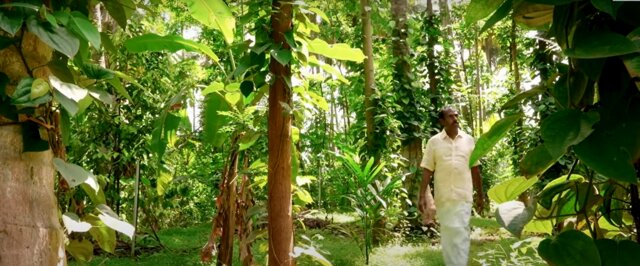
Transforming a coconut monocrop into a multi-storey food … [India]
Transforming a monocrop coconut farm into a resilient food forest can sustainably enhance soil health, biodiversity and productivity while reducing labour and external input requirements. This demonstrates the potential to increase yields and provide long-term economic and ecological stability for farmers.
- Compiler: Praveena Sridhar
2. Description of the SLM Approach
2.1 Short description of the Approach
The approach focuses on supporting farmers to increase productivity by increasing soil biology and organic matter content, primarily through plant residue and animal waste. Awareness and advocacy are followed by training programs and support for adopting regenerative agricultural practices.
2.2 Detailed description of the Approach
Detailed description of the Approach:
The Save Soil Farmer Training and Handholding approach seeks to combat soil degradation by promoting practices that increase soil organic matter content to 3% or above. The objectives include enhancing soil health through boosting organic matter, which improves underground water storage, green cover, biodiversity, and food security. By integrating traditional knowledge with modern techniques, this approach aims to restore soil health through simple, adaptable methods such as tree-based agriculture (agroforestry), organic mulching, crop rotation, cover cropping, and using natural composts that increase soil organic matter while minimizing disturbance. The approach focuses on marrying ecology with economy, ensuring that regenerative practices are both economically and environmentally viable.
Widespread implementation begins with awareness and advocacy, followed by training programs for farmers and support for adopting regenerative agricultural practices. Initially, farmers were sceptical due to the time required for soil regeneration compared to simply adding synthetic inputs. However, the long-term benefits—such as improved soil health, stable yields, and reduced reliance on chemical fertilizers—have led to increased acceptance. Over the past 20 years, this approach has transformed agriculture in Tamil Nadu, focusing on farm economics and agroecology. Training, support, and resources have been offered to help farmers adopt regenerative agriculture for major crops in the region.
The strategy of the approach is to start with medium-sized landholders first, who can take risks and later serve as volunteer trainers. This "raindrop model" spreads knowledge effectively, empowering farmers to educate others, which builds trust and accelerates adoption. Farmers receive training in crop management, livestock care, efficient water use, and pest control, while model farms serve as educational hubs showcasing regenerative techniques.
Over 45,000 farmers have been trained in regenerative farming techniques, 400+ WhatsApp groups linking 88,000 farmers have been formed, and thousands of consultations provided through helplines. A vibrant community now exists comprised of over 250 lead farmers driving natural farming adoption across Tamil Nadu. A dedicated team of 160 field executives conducted 33,000 individual on-farm consultations in 2023, providing personalised support to farmers, including soil and water testing and recommending regionally-appropriate tree varieties. Production and distribution of high-quality organic saplings to participating farmers at a nominal cost encouraged greater participation. 229,000 farmers across Karnataka and Tamil Nadu have transitioned to tree-based agriculture, with 116 million saplings enabled by farmers and community participation. Women's empowerment is emphasized, with many nurseries operated by women, contributing to their economic upliftment and community involvement.
2.3 Photos of the Approach
General remarks regarding photos:
These photos are only a few representations of the voluminous work undertaken by farmers and volunteers on-the-ground over the past two decades.
2.4 Videos of the Approach
Comments, short description:
Introduction to Save Soil TKV Operations
Date:
28/10/2024
Location:
https://www.youtube.com/watch?v=FheZ_Os_Yg0
Name of videographer:
Save Soil - Cauvery Calling
Comments, short description:
Farmer Production Nursery, Puducherry
Date:
11/02/2024
Location:
https://youtu.be/QxZBMMi14-A?feature=shared
Name of videographer:
Save Soil Media Team
Comments, short description:
Why Plant Trees on the Borders, part 1
Date:
20/08/2023
Location:
https://www.youtube.com/watch?v=kep6WkNMJgg
Name of videographer:
Save Soil Media Team
2.5 Country/ region/ locations where the Approach has been applied
Country:
India
Region/ State/ Province:
Tamil Nadu and Karnataka
Comments:
All the operations of the Farmer Trainings and Handholding are initiated from headquarters in Coimbatore. Hundreds of volunteers offer their services full-time for the project. Activities are spread across all the districts of Tamil Nadu and 9 southern districts of Karnataka that are in the Cauvery River Basin.
Map
×2.6 Dates of initiation and termination of the Approach
Indicate year of initiation:
2007
If precise year is not known, indicate approximate date when the Approach was initiated:
10-50 years ago
Comments:
This project will continue until the vision of making regenerative agriculture a mainstream phenomena is achieved. As an organization, we are focused on creating model farms and training expert farmers who will lead the movement and inspire widespread adoption. In parallel, we are advocating for supportive policies to drive government action. The project will not have a formal termination date, as our commitment is to ensure the long-term success and sustainability of regenerative agriculture, and we will continue our efforts until this goal is fully realized.
2.7 Type of Approach
- project/ programme based
2.8 Main aims/ objectives of the Approach
The aim is to transform agriculture by focusing on farm economics and agroecology, starting with the states of Tamil Nadu and Karnataka (in and around the Cauvery River Basin). Challenges of vanishing farmers and degrading soils are addressed by training and supporting farmers in scientific regenerative agriculture techniques, with a vision to make regenerative agriculture mainstream through a people's movement. The objective of this approach is to serve as both an economic model for farmers and a method for large-scale ecological impact, aiming to revive soil, revitalize rivers, and increase farmer income across the tropical world.
2.9 Conditions enabling or hindering implementation of the Technology/ Technologies applied under the Approach
social/ cultural/ religious norms and values
- enabling
Eastern cultures are deeply rooted in nature worship, a value embedded in farming communities. Save Soil association with the Isha Foundation aligns well with this cultural identity, supporting acceptance and integration of regenerative farming practices.
availability/ access to financial resources and services
- enabling
The technologies promoted are inherently cost-effective compared to conventional methods, making them easier for farmers to adopt. Moreover, the services offered by Save Soil are largely free, which facilitates participation without financial barriers.
- hindering
Upfront financial incentives to make a shift in approach as there might be initial loss of income when shifting from conventional methods because it takes time for farmers to practically learn and understand the techniques.
institutional setting
- enabling
Farmers who have experienced negative effects from chemical usage often prefer a farmer-to-farmer support system. Save Soil’s structure as a farmer-driven movement, rather than a top-down project, fosters a strong sense of ownership and community among participants.
collaboration/ coordination of actors
- enabling
Collaboration with government entities has enabled policy shifts, fostering broader adoption of sustainable farming practices.
legal framework (land tenure, land and water use rights)
- hindering
Ambiguities in land tenure and water rights create challenges for farmers in making long-term investments in sustainable practices. This limits participation to farmers with secure tenure rights.
policies
- enabling
Recent policies are increasingly supportive of nature-based solutions, which helps create a conducive environment for the adoption of these technologies.
- hindering
The lack of explicit state policy support for regenerative farming limits its adoption. However, relaxation in timber harvest and sale policies for timber has enabled farmers to plant specific tree species.
land governance (decision-making, implementation and enforcement)
- enabling
The technologies are primarily implemented by traditional farmers on their private land, which minimises governance-related issues.
knowledge about SLM, access to technical support
- hindering
A generational knowledge gap has hindered the immediate adoption of traditional SLM practices. Save Soil aims to revive this valuable knowledge to benefit current farming practices.
markets (to purchase inputs, sell products) and prices
- enabling
There is demand for timber and naturally grown foods
- hindering
There is no established marketplace for timber for farmers to get a fair price.
Consumers are often hesitant to demand natural produce due to higher prices, limited availability, and lack of assurance. Direct marketing platforms are being developed to help farmers address these challenges.
workload, availability of manpower
- hindering
Agriculture is currently unattractive to many farmers, leading to migration to cities or other professions. This issue affects both conventional and regenerative farming practices, resulting in labor shortages.
3. Participation and roles of stakeholders involved
3.1 Stakeholders involved in the Approach and their roles
- local land users/ local communities
Local farmers and community members are the primary implementers of sustainable practices.
They adopt the regenerative techniques promoted by Save Soil and actively contribute to the success of the approach by sharing their experiences and inspiring others.
- SLM specialists/ agricultural advisers
SLM specialists and agricultural advisers provide technical guidance and training to local farmers.
They help ensure that the recommended practices are effectively implemented and tailored to local conditions.
- researchers
Researchers contribute by conducting studies to assess the impact of sustainable practices on soil health, crop yields, and ecosystem resilience.
They also help in refining and improving the techniques used.
- teachers/ school children/ students
Teachers and students play an important role in spreading awareness.
Schools organise educational programs and activities that introduce the younger generation to the importance of soil health and sustainable agriculture in our model farms.
- private sector
The private sector contributes by providing resources, such as inputs and funding, and by creating market linkages for sustainably produced goods.
Their involvement helps to build an ecosystem that supports natural farming practices.
- local government
Local government bodies
They assist in creating a conducive environment for implementing sustainable practices by supporting community initiatives and providing local-level policy support.
- national government (planners, decision-makers)
The national government plays a key role in policy formulation and advocacy.
Planners and decision-makers work to integrate regenerative agriculture into national policies, which helps in scaling the movement.
If several stakeholders were involved, indicate lead agency:
The lead agency is Conscious Planet - Save Soil
3.2 Involvement of local land users/ local communities in the different phases of the Approach
| Involvement of local land users/ local communities | Specify who was involved and describe activities | |
|---|---|---|
| initiation/ motivation | interactive | Volunteers helped to identify problems, investigate causes, search for solutions, initiate pilot projects, and create a plan to address issues. |
| planning | interactive | The chosen concept enters the planning phase, during which volunteers engage with various stakeholders to create a strategy and plan of action. |
| implementation | interactive | The program is implemented by volunteers on the ground, carrying out targeted activities to achieve the specific outcomes and goals that have been set. |
| monitoring/ evaluation | interactive | The project is monitored by higher-level management to ensure its effectiveness, integrity, and adherence to the core objectives. |
3.3 Flow chart (if available)
Description:
The Training and Awareness team designs annual training plans, with farmers enrolling via WhatsApp team ads, based on content from the Content Creation team. After training, farmers are encouraged to join a WhatsApp group for updates. For technical queries, farmers contact the 12x7 helpline, and the Call Center Team records and analyses the issues with the central team to provide the necessary assistance. If an issue requires a Field Visit, the Field Visit Team supports the farmer on-site, they also identify expert farmers during this process and forward their data to the Training Team for future collaboration. To support the above process a model farm is established to train trainers, field staff, volunteers, and farmers. The central team also monitors the staff hiring, accounting, compiling reports and other administrative processes.
Author:
Aditya Tated
3.4 Decision-making on the selection of SLM Technology/ Technologies
Specify who decided on the selection of the Technology/ Technologies to be implemented:
- mainly SLM specialists, following consultation with land users
Explain:
SLM experts suggest solutions for the land, and farmers decide if they agree, with experts offering alternative suggestions until the farmer is satisfied.
Specify on what basis decisions were made:
- evaluation of well-documented SLM knowledge (evidence-based decision-making)
- research findings
- personal experience and opinions (undocumented)
4. Technical support, capacity building, and knowledge management
4.1 Capacity building/ training
Was training provided to land users/ other stakeholders?
Ja
Specify who was trained:
- land users
- field staff/ advisers
- Volunteers
If relevant, specify gender, age, status, ethnicity, etc.
Farmers, Volunteers : Both men and women in an 80:20 ratio, with individuals aged between 20 and 50 years.
Staff : Both men and women in a 50:50 ratio, with individuals aged between 20 and 50 years.
Form of training:
- on-the-job
- farmer-to-farmer
- demonstration areas
- public meetings
- courses
Subjects covered:
The training covered a wide range of subjects related to regenerative agriculture, including preparation of inputs, crop specific practices for all the major crops and vegetables in the region, value addition of farm produce, livestock management, marketing and sales, a complete knowhow on timber species, seed selection, input preparation and application, biological pest management, harvesting techniques, value addition, and marketing strategies for many timber species.
On-ground farm visit support is provided to choose the right tree species depending on soil type, soil depth and water availability and post plantation support for tree growth and care is provided.
Apart from educating farmers in regenerative agriculture, some of the farmers are also trained to produce and distribute saplings in their own farms providing them another livelihood opportunity, they are provided with buybacks arrangement and performance incentives.
Comments:
Training was conducted by several resource leaders, including experts invited to train field staff and volunteers. Volunteers are also participating in courses offered by international organisations such as the Soil Food Web School. In addition, volunteers were given opportunities for site visits to interact with farmers and understand on-the-ground realities. Hands-on experience was provided through extended work on model farms to grasp the nuances of regenerative practices. Public meetings and awareness campaigns, like Rally for Rivers and Cauvery Calling, were organised over 2-3 months, involving a large number of volunteers to spread mass awareness of upcoming initiatives.
4.2 Advisory service
Do land users have access to an advisory service?
Ja
Specify whether advisory service is provided:
- on land users' fields
- at permanent centres
Describe/ comments:
We have 11 trained staff who visited 1490 farmers all across the state out of which 1006 were fully transitioned and 484 were transitioning in this financial year alone for handholding and guidance. They also identified over 630 lead farmers and over 207 expert farmers. 206 farms have the possibility to conduct training programs and 173 farms have the possibility of an awareness video shoot.
Farmers have access to multiple advisory services through our initiatives. We offer a dedicated farmer helpline, along with on-ground consultations, to provide direct assistance and guidance. Additionally, our WhatsApp group serves as a continuous platform where farmers can ask questions and share knowledge.
For queries that extend beyond routine advice, we escalate the matter to connect the farmer with a relevant expert within our team or with experienced model farmers in our network. This layered advisory approach ensures that all farmers receive tailored support, whether for everyday inquiries or specialized issues, helping them make informed decisions for their agricultural practices.
160 on-ground executives are doing on-ground consultations across the project region. In the last financial year, more than 32,000 consultations happened, farmer helpline team of 20-25 volunteers resolved more than 10,000 queries and 50,000 farmers are nurtured daily via more than 200 Whatsapp groups.
4.3 Institution strengthening (organizational development)
Have institutions been established or strengthened through the Approach?
- no
4.4 Monitoring and evaluation
Is monitoring and evaluation part of the Approach?
Ja
If yes, is this documentation intended to be used for monitoring and evaluation?
Nee
4.5 Research
Was research part of the Approach?
Ja
Specify topics:
- sociology
- economics / marketing
- ecology
- technology
- Policy
Give further details and indicate who did the research:
Volunteers under the guidance of agricultural experts, scientists, economists, and agronomists completed the research
5. Financing and external material support
5.1 Annual budget for the SLM component of the Approach
Indicate the annual budget for the SLM component of the Approach in US$:
6200000.00
Comments (e.g. main sources of funding/ major donors):
Major donations are secured from corporate partners through their Corporate Social Responsibility (CSR) initiatives, with a commitment typically made on an annual basis. As such, we engage in annual fundraising efforts to secure continued support for the project. Another source is Institutional Fundings.
5.2 Financial/ material support provided to land users
Did land users receive financial/ material support for implementing the Technology/ Technologies?
Ja
If yes, specify type(s) of support, conditions, and provider(s):
Subsidised Saplings provided by Save Soil - Cauvery Calling Campaign
5.3 Subsidies for specific inputs (including labour)
- agricultural
| Specify which inputs were subsidised | To which extent | Specify subsidies |
|---|---|---|
| Saplings | partly financed | Timber saplings are provided to farmers at 90% subsidized rate, just at 4 cents |
Comments:
Subsidizing saplings play a major role in helping farmers transition to tree-based regenerative agriculture.
5.4 Credit
Was credit provided under the Approach for SLM activities?
Nee
5.5 Other incentives or instruments
Were other incentives or instruments used to promote implementation of SLM Technologies?
Ja
If yes, specify:
The training is provided at a bare minimum cost just to ensure their full participation. A regularly updated, free, online knowledge repository of best practices is created for farmers to make use of at any point of time
Farmers who are trained in running distribution nurseries are provided incentives on each sale of sapling. There is also an assured buy-back arrangement, guaranteeing a market for the produced saplings
Incentive of Rs 125/ sapling from the Government of Karnataka to farmers in the first 3 years for up to 400 saplings per hectare, based on sapling survival rates.
6. Impact analysis and concluding statements
6.1 Impacts of the Approach
Did the Approach empower local land users, improve stakeholder participation?
- No
- Yes, little
- Yes, moderately
- Yes, greatly
The approach has empowered farmers by providing financial stability. This has also instilled pride in the profession as many were on the verge of quitting.
Did the Approach enable evidence-based decision-making?
- No
- Yes, little
- Yes, moderately
- Yes, greatly
Soil quality improvements have been evidenced through soil tests, but farmers mainly focus on economic benefits. Efforts are ongoing to collect comprehensive economic data to support evidence-based decision-making. We learnt if ecological changes are to be seen on a scale, then farmers must be involved as they own more than 50% land, hence as an approach we enabled farmers to take up tree plantation in farmlands. Farmers plant trees on their land and take appropriate care ensuring high survival rate of trees.
Did the Approach help land users to implement and maintain SLM Technologies?
- No
- Yes, little
- Yes, moderately
- Yes, greatly
Due to the simplicity of the approach, one-third of trained farmers have fully transitioned to sustainable practices, and 225,000 farmers have adopted long-duration timber crops after observing guaranteed financial returns.
Did the Approach improve coordination and cost-effective implementation of SLM?
- No
- Yes, little
- Yes, moderately
- Yes, greatly
The farmer-to-farmer learning model has proven to be the most cost-effective and efficient method for spreading farming techniques
Did the Approach mobilize/ improve access to financial resources for SLM implementation?
- No
- Yes, little
- Yes, moderately
- Yes, greatly
Access to financial resources remains limited, as the approach yields long-term benefits, whereas donors often seek short-term results. Donations are frequently short-lived, moving on to other areas of action.
Did the Approach improve knowledge and capacities of land users to implement SLM?
- No
- Yes, little
- Yes, moderately
- Yes, greatly
Continuous engagement through social media, WhatsApp, and helplines has kept handholding support robust, increasing farmers' interest and knowledge over time.
Did the Approach improve knowledge and capacities of other stakeholders?
- No
- Yes, little
- Yes, moderately
- Yes, greatly
Farmers have demonstrated the effectiveness of the approach, gaining recognition from consumers and the government. Government officials have consulted and signed MoUs, acknowledging the significant progress made.
Did the Approach build/ strengthen institutions, collaboration between stakeholders?
- No
- Yes, little
- Yes, moderately
- Yes, greatly
The collaboration between farmers and consumers has strengthened, benefiting both parties and supporting the movement's growth and future establishment as a mainstream practice.
Did the Approach mitigate conflicts?
- No
- Yes, little
- Yes, moderately
- Yes, greatly
The primary conflict is between policymakers and farmers, many of whom are burdened by defunct policies and debts. Regenerative farmers have seen reduced debt, helping to alleviate these conflicts.
Did the Approach empower socially and economically disadvantaged groups?
- No
- Yes, little
- Yes, moderately
- Yes, greatly
The focus is on the farming community, with farmers working across the state in isolation. No direct efforts have been made to empower other socially disadvantaged groups.
Did the Approach improve gender equality and empower women and girls?
- No
- Yes, little
- Yes, moderately
- Yes, greatly
Approximately 25-30% of participants are women, many of whom have shared their success stories publicly. These women are leading the way in demonstrating gender equality in agriculture.
Did the Approach encourage young people/ the next generation of land users to engage in SLM?
- No
- Yes, little
- Yes, moderately
- Yes, greatly
The approach combines ecological and economic benefits, attracting a large number of young people to the training programs.
Did the Approach improve issues of land tenure/ user rights that hindered implementation of SLM Technologies?
- No
- Yes, little
- Yes, moderately
- Yes, greatly
The approach does not address farmers with land tenure issues, resulting in no direct impact on this area.
Did the Approach lead to improved food security/ improved nutrition?
- No
- Yes, little
- Yes, moderately
- Yes, greatly
Families that have adopted chemical-free farming practices have seen improvements in health, contributing to better food security and nutrition.
Did the Approach improve access to markets?
- No
- Yes, little
- Yes, moderately
- Yes, greatly
The Farmer Producer Organization (FPO) program has improved access to fair markets for both selling produce and purchasing inputs. Farmers are also supported to engage in direct marketing to secure stable prices.
Water for home use and sanitation are not significant issues for farmers in this region. The project's long-term goal is to replenish tributaries and the Cauvery River, which serves as the region's lifeline.
Did the Approach lead to more sustainable use/ sources of energy?
- No
- Yes, little
- Yes, moderately
- Yes, greatly
The elimination of chemicals contributes to more sustainable energy use, supporting the movement towards overall sustainability.
Did the Approach improve the capacity of the land users to adapt to climate changes/ extremes and mitigate climate related disasters?
- No
- Yes, little
- Yes, moderately
- Yes, greatly
Tree-based agriculture has increased water-holding capacity, making farmers more resilient to droughts and floods.
Did the Approach lead to employment, income opportunities?
- No
- Yes, little
- Yes, moderately
- Yes, greatly
The approach has provided stability of income through short-, medium-, and long-term returns. Vegetables provide year-round income, while value addition training and cost-reduction strategies have benefited many farmers. Income opportunities for 62 farmers running nurseries have opened up and employment of 400 women in Cauvery Calling run 31 nurseries
6.2 Main motivation of land users to implement SLM
- increased production
Tree-based agriculture and regenerative agriculture practices build soil health and allow a greater variety of crops to be grown together, thus increasing production
- increased profit(ability), improved cost-benefit-ratio
Sustainable Soil Management practices reduce input costs and lead to greater profits
- reduced workload
Sustainable Soil Management practices build soil organic matter and soil biology, reducing the need for weeding, tilling, etc.
- payments/ subsidies
Act as a safety net for farmers to try the new farming practices and approaches
6.3 Sustainability of Approach activities
Can the land users sustain what has been implemented through the Approach (without external support)?
- yes
If yes, describe how:
The approach is taught to farmers over an extended period using a variety of methods and technologies. During the transition, farmers receive comprehensive support, from purchasing inputs, getting subsidized saplings to marketing their produce. Costs are significantly reduced, and soil quality continues to improve, leading to tangible ecological and economic benefits. The movement is gaining momentum, reducing the risk of reverting to unsustainable practices due to peer support and shared success. The younger generation is increasingly interested in sustainable farming, and improvements in health further incentivize farmers to continue these practices, ensuring long-term sustainability without external support.
6.4 Strengths/ advantages of the Approach
| Strengths/ advantages/ opportunities in the land user’s view |
|---|
| Reduced Costs: The overall cost of agricultural inputs and operations is decreasing due to reduced dependency on chemical fertilisers and pesticides, making farming more economical. |
| Improved Quality and Quantity of Produce: Farmers have observed significant improvements in both the quality and the quantity of their produce, which has led to healthier crops and higher yields. |
| Better Market Prices: Due to the high quality of the produce, farmers are able to command better prices compared to conventional methods, increasing their profitability and improving their livelihoods. |
| Insurance: Long-term timber trees on farmlands acts as an insurance and security in times of need |
| Reduced Drudgery: The adoption of regenerative practices has made farming less labor-intensive and physically demanding, thereby reducing drudgery and improving the overall quality of life for farmers and their families. |
| Strengths/ advantages/ opportunities in the compiler’s or other key resource person’s view |
|---|
| Healthier Produce for Consumers: The produce grown using the Save Soil approach is healthier for consumers, being free from harmful chemical residues and rich in nutrients. |
| Eco-Friendly Approach: The practices are environmentally sustainable, contributing to improved soil health, reduced chemical runoff, and better biodiversity. This approach helps mitigate the effects of climate change by promoting carbon sequestration and enhancing ecosystem resilience. |
| Scalability to the Tropical World: The approach is highly scalable and can be adopted across the tropical world, where similar soil conditions and farming practices exist. This adaptability makes it a viable solution for addressing global soil degradation. |
| Reduction in Rural Economic Distress: The approach contributes to reducing rural economic distress by providing farmers with stable income opportunities, reducing input costs, and offering new avenues for income through value-added products and diversified cropping systems. |
| Timber market: If farming in India becomes tree-based, the import of timber will reduce (India is one of the world’s top 3 timber importers- In 2019, India imported INR 428.4 billion worth of wood and wood products)., and the government will save the FOREX |
6.5 Weaknesses/ disadvantages of the Approach and ways of overcoming them
| Weaknesses/ disadvantages/ risks in the land user’s view | How can they be overcome? |
|---|---|
| 1) Longer Learning Curve:The approach involves a significant learning curve, requiring farmers to acquire new skills and adapt to different practices compared to conventional methods. | More training programs and continuous handholding services are essential to support farmers during this transition. Providing one-to-one mentorship and practical demonstrations can help accelerate learning and build confidence. |
| 2) Initial Capital Investment and Labor Requirement: Implementing regenerative practices requires initial investments in equipment, inputs, and additional labor, which can be a challenge for many farmers. | Government support in the form of subsidies or low-interest loans can help farmers manage these initial costs. Collaborating with financial institutions to create tailored packages can also ease this burden. |
| 3) Better Market Access and Prices:Farmers need improved access to markets that recognize the value of sustainably produced goods and offer fair prices. | Digital direct marketing platforms can bridge the gap between farmers and consumers, allowing farmers to sell their produce directly at fair prices. Developing cooperative models for collective bargaining can also improve market access. |
| 4) Lack of Social Acknowledgement: Sustainable farming practices are not always socially recognized, which can deter farmers from transitioning. | Promoting consumer platforms that educate the public on the value of regenerative produce can help increase awareness and social acknowledgment. Highlighting success stories and building community support can further validate these efforts. |
| Weaknesses/ disadvantages/ risks in the compiler’s or other key resource person’s view | How can they be overcome? |
|---|---|
| 1) Limited Adoption:The approach is not yet widespread, limiting its impact on a broader scale. | Expanding the approach requires substantial efforts from all stakeholders, including farmers, NGOs, governments, and international organizations. Creating awareness campaigns and incentivizing early adopters can drive broader adoption. |
| 2) Lack of Funding for Projects: Funding for regenerative agriculture projects is often limited, which affects their scalability and continuity. | Sustainable, long-term funding from international institutions is necessary to ensure consistent support. Engaging philanthropic organizations and developing partnerships with global institutions can help secure such funding. |
| 3) Insufficient Farm Models: There are not enough model farms to demonstrate the benefits of the approach to a wider audience. | Creating more model farms across different regions can showcase the practical benefits of regenerative agriculture. These farms can serve as training and demonstration centers, helping to build trust and attract more farmers to adopt these practices. |
| 4)Lack of Political Will: Insufficient political support limits the adoption and integration of regenerative practices into mainstream agriculture. | Changing policies requires persistent efforts to build awareness among policymakers and demonstrate the long-term benefits of sustainable farming. Advocacy and lobbying by NGOs, farmers' groups, and other stakeholders can help influence policy shifts in favor of regenerative agriculture. |
7. References and links
7.1 Methods/ sources of information
- field visits, field surveys
- interviews with land users
- interviews with SLM specialists/ experts
- compilation from reports and other existing documentation
7.2 References to available publications
Title, author, year, ISBN:
RFR Draft Policy Recommendation, 2017
Available from where? Costs?
https://cdn.isha.ws/public/docs/pdir/RFR_RevitalizationOfRiversInIndia-Web.pdf, FREE DOWNLOAD
7.3 Links to relevant information which is available online
Title/ description:
Conscious Planet - Save Soil - Cauvery Calling
URL:
savesoil.org
Title/ description:
Save Soil - Cauvery Calling Youtube
URL:
https://www.youtube.com/@SaveSoil-CauveryCalling
Title/ description:
Save Soil Movement - A Movement that Began 24 years ago
URL:
https://isha.sadhguru.org/en/wisdom/video/save-soil-movement-began-24-years-ago
Links and modules
Expand all Collapse allLinks

Transforming a coconut monocrop into a multi-storey food … [India]
Transforming a monocrop coconut farm into a resilient food forest can sustainably enhance soil health, biodiversity and productivity while reducing labour and external input requirements. This demonstrates the potential to increase yields and provide long-term economic and ecological stability for farmers.
- Compiler: Praveena Sridhar
Modules
No modules


